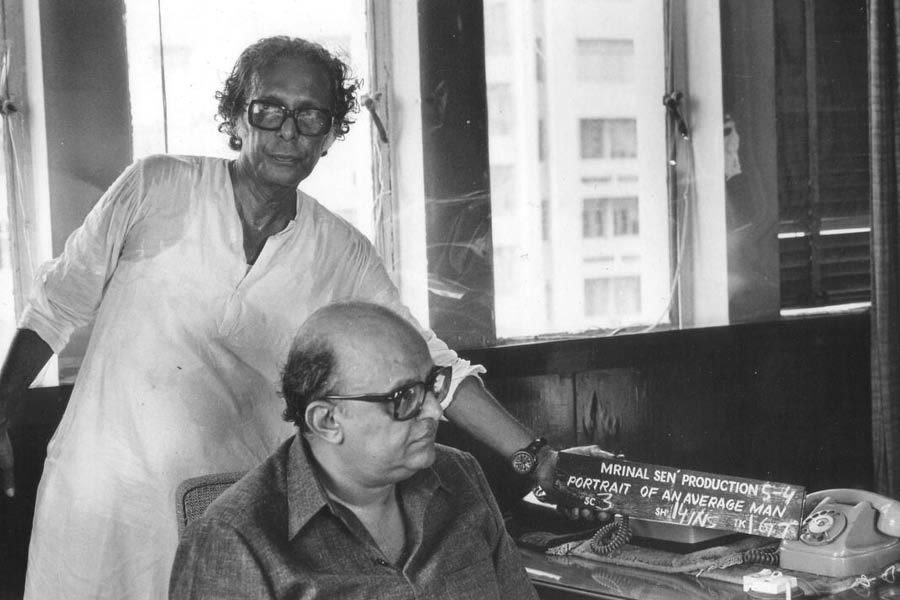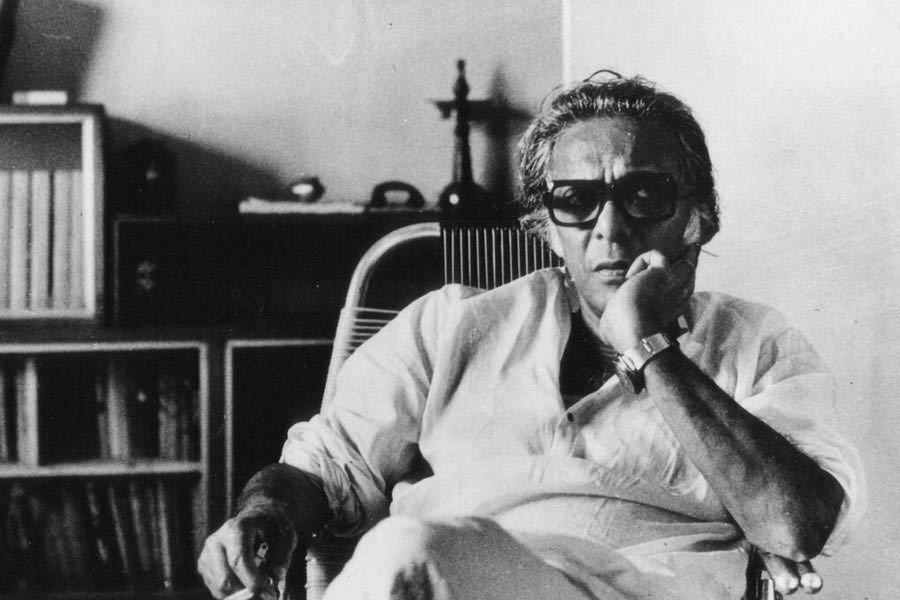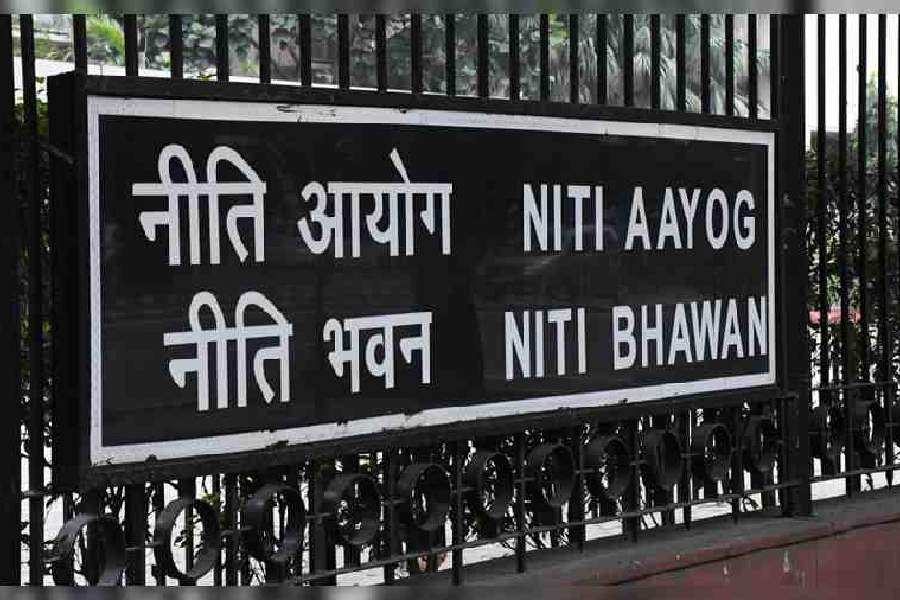Few Indian filmmakers have managed to use the medium as well as Mrinal Sen has, not only to tell a story but to record a moment in time as well, and to do it with honesty as cruel as it may be. That makes him not just a great filmmaker but also a historian. His oeuvre is a visual record of the lost Bengali after Independence, the birth of the Marxist Bengali in the 1970s and the death of the ideological Bengali in the wake of the fall of the Berlin Wall.
However, unlike his compatriots, among them Satyajit Ray and Ritwik Ghatak, Sen refused to be bound to Kolkata and Bengal. The restless and adventurous spirit that he was, he ventured into making films not only in Hindi, but also in Telugu and Odia. ‘I have no problem to move out to Africa and shoot a film in Swahili, because the language of poverty is universal,’ he said.
The shift out of Bengal was more or less forced upon him. After the creative and commercial highs of Neel Akasher Neechey (1959) and Baishey Shravana (1960), Sen hit a rough patch with back-to-back financial debacles Punascha (1961), Abasheshe (1963) and Pratinidhi (1964). Though Akash Kusum (1965) is today considered one of his most accomplished works, at the time the raging controversy arising out of Satyajit Ray’s comments on it took a heavy toll. With his options fast running out, Sen grabbed the opportunity offered by a Gujarati businessman in Odisha, Babulal Doshi. Keen to produce an ‘art’ film, Doshi gave him two conditions: Sen had to make a film in Odia and it had to be an adaptation of K.C. Panigrahi’s Matira Manisha, the novel that had fetched its writer the Sahitya Akademi Award.
This decision, driven by circumstances, had far-reaching consequences. Ray and many other Bengali filmmakers of the era had till then refused to make films in a language other than Bengali because, as Ray clarified, he was not familiar with the nuances of other languages. Sen shattered this belief and proved that it was possible to break the language barrier as film is a visual medium. He shot these films in remote locales in Saurashtra, Rajasthan and Telangana, thus paving the way for new filmmakers like Goutam Ghose and Biplab Roy Choudhuri, and even a veteran like Tarun Majumdar, to move out of Bengal. At the same time, unlike Bimal Roy and Hrishikesh Mukherjee, who never returned to Bengal, Sen held on to his roots in Kolkata.
Matira Manisha (1966; Odia)
K.C. Panigrahi’s novel is a classic, set in rural Odisha in the 1930s. As Sen’s biographer Dipankar Mukhopadhyay says, the text had an old-world charm, not unlike the works of Sarat Chandra Chattopadhay, and neither the story nor its style was modern in any way. Yet, Sen took it up and interpreted it in his own way (much like he would do with Premchand and Manto later), in the process making it his most autobiographical film, imbuing a period piece with contemporary reality.
The novel narrates the story of two brothers Baraju and Chhakadi — the former industrious and very much the archetypal elder brother, the latter more of a wanderer who does not want to work in the fields. Egged on by his wife Netramani, Chhakadi demands a division of property only to have the elder brother relinquish his claims and hand it all to his younger brother. There is no doubt in the novel that Chhakadi and Netramani are the culprits breaking up the good old joint family. But in the hands of Sen, these characters get a new perspective.
Sen’s sympathies clearly lie with them, and he stands by Netramani’s desire to carve out an independent life and make her own choice. As for Chhakadi, Sen moulds the character almost as his alter ego, and makes him the vessel for the individual’s rebellion against the establishment. In quintessential Sen manner, the ending does not spell out whether the two brothers reconcile. As he said, ‘It does not matter to me, nor should it to anybody, whether the brothers reunite… I leave the two adults to themselves and move the camera away.’
That he had dared to ‘tamper’ with the text of a classic earned him brickbats from numerous quarters, including the author who was upset with Sen. This would be a leitmotif in his adaptations – for him the original story was nothing more than a peg on which he hung his own structure, driven by his own sensibilities.
Take for example, Antareen (1993). The film’s credit titles mentioned that the film originated ‘from an idea based on a story by Saadat Hasan Manto’. After the film had been screened at the Calcutta International Film Festival, a journalist at a press conference asked Sen the title of the Manto story that had inspired the film. Instead of answering the journalist, Sen said, ‘Please go through the collected works of Manto and tell me the title of the story you think has served as the basis of my film.’
It was Sen’s way of communicating that the film was so different from the story that no one would be able to identify the source. That was an approach he consistently used in his adaptations from literary work. The screenplay of Bhuvan Shome came from only the last section of Banaphool’s story. He would often pick up a few sentences or a paragraph from a story and expand on them to develop his script. His Telugu film Oka Oorie Katha, based on Premchand’s immortal story Kafan, was no exception.
Bhuvan Shome (1969; Hindi)
Based on a Bengali story by Banaphool aka Balai Chand Mukhopadhyay, Sen’s maiden foray into Hindi ushered in the New Indian Cinema, along with Mani Kaul’s Uski Roti and Basu Chatterjee’s Sara Akash. Devoid of the trappings of everything Hindi cinema at the time stood for, Bhuvan Shome proved an unlikely commercial success, which surprised the director himself.
Sen has narrated how when the film was running in theatres in Bombay, he had taken a taxi from Andheri to Churchgate. The taxi driver was a garrulous person and to earn himself a breather from the constant chatter, Sen asked him if he had seen Bhuvan Shome. The driver stopped the car, looked back at Sen, and asked, ‘The film with the birds?’ Sen replied in the affirmative and the driver said it was a ‘top-class’ film. When Sen revealed his identity, the driver grabbed his hand, and at the end of the journey, the rest of which was spent in total silence, he refused to accept his fare from the director.
Bhuvan Shome proved to be another flashpoint between Ray and Sen, with the former giving what he called his ‘review in seven words: Big Bad Bureaucrat Reformed by Rustic Belle’. Taking the acerbic review in his stride, Sen, tongue firmly in cheek, reworked Ray’s words to: ‘Big Bad Bureaucrat Chastised by a Charmer’s Cheek’.

Mrinal Sen with Shyamanand Jalan
Oka Oorie Katha (1977; Telugu)
Arguably Sen’s cruellest film, this is as much an exposition of his unwillingness to settle for easy comfortable storytelling as it is an insight into his approach in adapting a literary work to screen. To begin with, Sen shifted the location of the story from Uttar Pradesh to Telangana. This was dictated by the film’s producer who had insisted that the film be made in his mother tongue, Telugu. As Sen said about this aspect of the change, ‘The descriptive passages in the story vividly recreate UP… the harsh winters of UP must have added to and enhanced the harshness of life. That cruel winter was absent in Telangana… Our logic, our understanding was: the despicability of poverty and the terror of exploitation are brutal realities, irrespective of seasonal changes. The relevance of Kafan is not dependent on any time of the year in particular.’
There were other dramatic changes he made to the story, rendering Oka Oorie Katha a work independent of its origins. The fundamental change lies in Sen’s approach to the character of Venkaiah and how that informs the film’s end, drastically different from the original. Ghisu, in Kafan, has been dehumanised beyond redemption. However, in the vision of Sen, Venkaiah is not just a victim of poverty who has lost what makes a man humane. Venkaiah is an iconoclast, an outsider. The title Oka Oorie Katha translates to ‘The Story of a Village’, but as Sen said in an interview, ‘We found a rather fitting subtitle in English… The Outsiders or The Marginal Ones.’ Sen’s Venkaiah has seen through the hollowness of social norms which he defies without compunction.
The ending and Sen’s interpretation shocked even Amrit Rai, Premchand’s son and a scholar in his own right. As Sen observed in his essay, ‘Cinema and Literature’, emerging from the screening, Rai told him, ‘It is a shattering film and a shattering experience, although I do not agree with your interpretation at all.’ Sen responded, ‘I am sure if your father had been alive today, his reaction wouldn’t have been any different.’ He then asked Rai with some trepidation, ‘Do you at this particular time regret allowing me to make a film based on the story?’ To which Rai, ever magnanimous, almost ‘shouted’, ‘Not at all. Why don’t you tell me when you will use another story for another film?’
Oka Oorie Katha was screened at the first-ever Indian Panorama in 1978 in Madras. Sen invited Satyajit Ray to the screening. However, Ray was reluctant to come as the film had not been subtitled (it became mandatory from the year after) and Ray was afraid that he would not understand a word. Sen managed to persuade Ray to sit in for a while. After the screening, Ray hailed him, shaking his hands, ‘Thank you for persuading me. I would have really missed something.’
Khandhar (1984; Hindi)
Universally regarded as his finest film, along with Akaler Sandhane (both films have interesting similarities: a man with a camera, city folk visiting a village and leaving painful scars behind), Khandhar is also probably Sen’s most lyrical and humane work where he sheds his engagement with radical politics and class struggle to metamorphose, in the words of a critic, from ‘a fire-eating polemicist into a poet of understated delicacy’. The dreamlike quality of Premendra Mitra’s original story Telanpota Abishkar attracted the filmmaker in Sen. Interestingly, Purnendu Pattrea had, in the 1960s, made a Bengali film based on the story, starring Madhabi Mukherjee in the role essayed by Shabana Azmi in Sen’s version.
For once, Sen remained faithful to the original story, even retaining some of its dialogues. But in trademark Sen style, he gave the story, written close to 50 years earlier, contemporary trappings, not least in making the protagonist a photographer (the original does not define a profession), which lends Khandhar an entirely new dimension. A photographer watches and records, refraining from either commenting or creating. This renders the climactic confrontation between a man who lives through visuals and an old lady who lives in a world rendered dark by her blindness rich in symbolism.
Sen demonstrates his understanding of human frailty and his mastery of the craft in pulling off the understated interaction between the characters, the many shades of emotions not articulated, and in the manner the tension arising out of a simple misunderstanding is never allowed to flag. You almost will the protagonists to talk it out but the director is not going to give you that vicarious redemption.
Shabana Azmi, who was an integral part of this period of Sen’s cinema, remembers, ‘The protagonist Jamini is a character I love deeply and strange though it may seem, I saw a lot of Mrinalda in her. Her vulnerability, her self-respect, her refusal to be a victim. I was traumatised when Mrinalda decided to do my last shot in the film where my face seems to get embedded into the ruins as my first shot. I protested but he would have none of it! In hindsight I think that’s what helped me internalise Jamini completely. It was a risk but it worked because of his confidence in being able to pull it off. I was surprised to discover that I may have a gregarious exterior but there is also a shy Jamini in the recesses of my being. I’m thankful to Mrinalda for helping me discover that.’

Mrinal Sen with Shabana Azmi during the shooting of Khandhar (1984) mrinalsen.org
Genesis (1986; Hindi)
Sen’s attempted masterpiece, his magnum opus, which does not quite come off but still manages to convey, symbolically, within the confines of a ruined village and through the interactions of four people the story of human civilisation. There are unmistakable links between Khandhar and Genesis, which make it possible to see the latter as a possible extension of the former. Khandhar closes with a blow-up of Jamini looking at the audience, the photographer busy with his camera, and the realisation that both Jamini and the photographer are lonely in their own ways, inhabiting their own ruins. In Genesis, Sen decided to place three individuals in ‘the loneliest part of the planet’.
While Samaresh Basu’s story Uratia (which was also later filmed by Buddhadeb Dasgupta as Uttara) provided the foundation for the film, the parable-like quality that Genesis has owes itself to Sen’s awareness of Sergei Eisenstein’s plans to make a film on Das Kapital and his own desire to incorporate Friedrich Engels’s theory as articulated in The Origin of the Family, Private Property and the State.
The serendipitous choice of location – described by his biographer as ‘the ideal necropolis, the graveyard of civilization’, which in itself calls for a feature of its own – gives Genesis a sense of timelessness as Sen provides a portrait of the rise and fall of civilisation without rooting the story to a specific time or place.
The title of the film is biblical and the themes it explores echo the biblical notions of creation and destruction. An abandoned village turns into an Eden with the coming of the three protagonists – the weaver, the farmer and the woman – but destruction looms in the form of the fourth, the merchant, who is both Satan and God. He will tempt and lead the trio to destruction and then create a new world in his own image. And yet, Sen’s lifelong engagement with Marxism looms large over the narrative, in particular in the closing as bulldozers and modern machinery raze the surroundings and the workers are overpowered by the tools of capitalism. There is of course the intense personal in the political, the immediate contemporary enmeshed in the historical as the woman tells the two men before she disappears from their lives: ‘We three became one but today you want to exert your rights. You have come to own me. The enemy is not outside but in you.’
Unfortunately, Genesis proved a flawed work and failed to resonate either with critics or with audiences. What also went against it was Naseeruddin Shah’s rant. ‘The film was a load of crap,’ he said in response to a question on its commercial failure. ‘I kept wondering while working in it — what am I doing in this film? What am I doing in a Mrinal Sen film anyway?’ Sen himself realised that he had failed to translate his ideas to the screen and that realisation loomed large over his next film.

Mrinal Sen behind the camera. mrinalsen.org
Ek Din Achanak (1989; Hindi)
Strongly echoing – both in its title and its basic concept – his 1979 film Ek Din Pratidin, this is one of his most personal and contemplative films. In Ek Din Pratidin, the daughter goes missing till late into the night, causing an upheaval in family and societal dynamics. In Ek Din Achanak, it is the family patriarch who walks out one evening, never to return. His family of four – wife, son and two daughters – wait for him to come back, but in vain. Sen does not provide a closure in any way and keeps the fate of the man a mystery.
Sen developed the screenplay from a novel by Ramapada Choudhury, Beej, in which one sentence caught his attention: ‘The saddest thing about life is that you live only once.’ The doubts that gnawed at Sen in the aftermath of the failure of Genesis finds an echo in that of Sasanka Roy, the professor in Ek Din Achanak, who leaves home and never returns. Talking about a day during the shoot, Shabana Azmi, who played the elder daughter, says, ‘Mrinalda was in an unusually quiet mood. When I asked what was bothering him he said, “Perhaps the character disappears in the film because he has come to terms with his own mediocrity. Maybe it’s time I face my own.” I didn’t say anything, just sat by his side holding his hand. I knew he needed quiet time on his own. Mrinal Sen was by no means mediocre but the fact that he had the courage to question himself with objectivity made him who he was. I held back the tears that had filled my eyes and quietly started humming a tune.’
Talking about the film, Sen said, ‘I wish I could start from scratch. I have done good, bad and indifferent films. I wish I could erase it all and start afresh like the professor who walked out on his family on a rainy day without even as much as informing anybody. One of the characters says, “One of the saddest things in life is that you live only one life.” However famous you are, you are aware of your mediocrity in certain respects. When you realise that, you face a crisis that is insurmountable. Though I have an enviable position as a maker of good, bad and indifferent films, I cannot escape this feeling of mediocrity within. Perhaps it happens because we are too immersed in our own selves.’
(Shantanu Ray Chaudhuri is a film and music buff, editor, publisher, film critic and writer)










